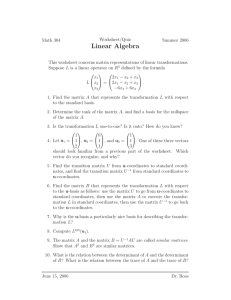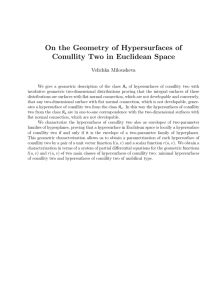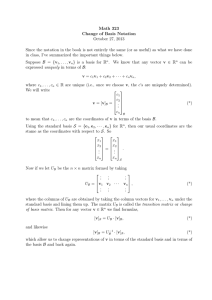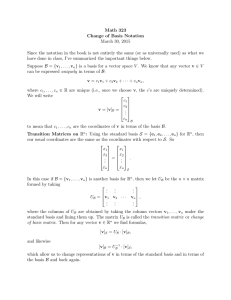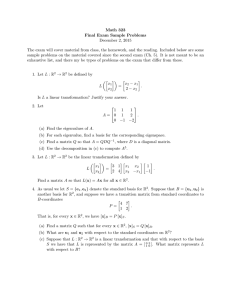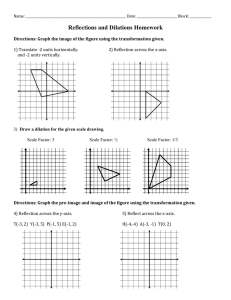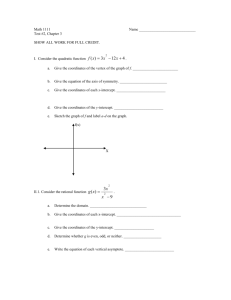ON LOCAL GEOMETRY OF FINITE MULTITYPE HYPERSURFACES
advertisement
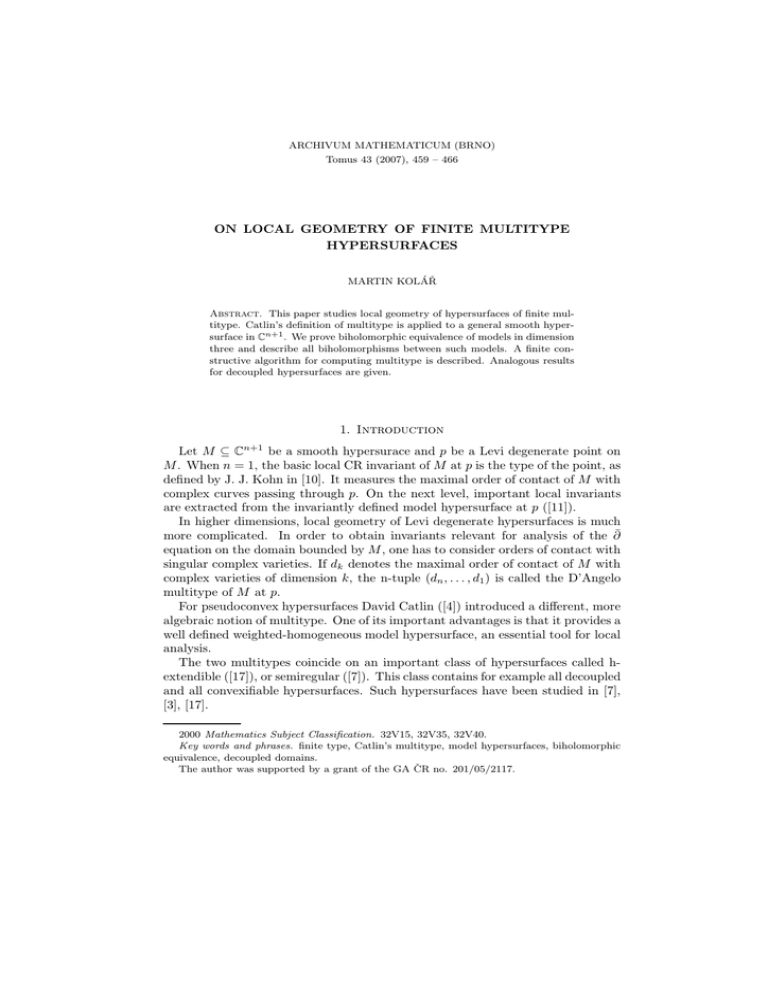
ARCHIVUM MATHEMATICUM (BRNO)
Tomus 43 (2007), 459 – 466
ON LOCAL GEOMETRY OF FINITE MULTITYPE
HYPERSURFACES
MARTIN KOLÁŘ
Abstract. This paper studies local geometry of hypersurfaces of finite multitype. Catlin’s definition of multitype is applied to a general smooth hypersurface in Cn+1 . We prove biholomorphic equivalence of models in dimension
three and describe all biholomorphisms between such models. A finite constructive algorithm for computing multitype is described. Analogous results
for decoupled hypersurfaces are given.
1. Introduction
Let M ⊆ Cn+1 be a smooth hypersurace and p be a Levi degenerate point on
M . When n = 1, the basic local CR invariant of M at p is the type of the point, as
defined by J. J. Kohn in [10]. It measures the maximal order of contact of M with
complex curves passing through p. On the next level, important local invariants
are extracted from the invariantly defined model hypersurface at p ([11]).
In higher dimensions, local geometry of Levi degenerate hypersurfaces is much
more complicated. In order to obtain invariants relevant for analysis of the ∂¯
equation on the domain bounded by M , one has to consider orders of contact with
singular complex varieties. If dk denotes the maximal order of contact of M with
complex varieties of dimension k, the n-tuple (dn , . . . , d1 ) is called the D’Angelo
multitype of M at p.
For pseudoconvex hypersurfaces David Catlin ([4]) introduced a different, more
algebraic notion of multitype. One of its important advantages is that it provides a
well defined weighted-homogeneous model hypersurface, an essential tool for local
analysis.
The two multitypes coincide on an important class of hypersurfaces called hextendible ([17]), or semiregular ([7]). This class contains for example all decoupled
and all convexifiable hypersurfaces. Such hypersurfaces have been studied in [7],
[3], [17].
2000 Mathematics Subject Classification. 32V15, 32V35, 32V40.
Key words and phrases. finite type, Catlin’s multitype, model hypersurfaces, biholomorphic
equivalence, decoupled domains.
The author was supported by a grant of the GA ČR no. 201/05/2117.
460
M. KOLÁŘ
In this paper we use Catlin’s definition of multitype for a general smooth hypersurface in Cn+1 , not necessarily pseudoconvex. As an important consequence,
we obtain a well defined model, with all the convenient properties familiar from
dimension two.
Since the definition itself is nonconstructive, and the models are not uniquely
defined, it is not a priori clear what is the relation between various models. In
many situations, when low order boundary invariants are needed, it is enough to
choose an arbitrary model. However, in order to study higher order CR invariants
it is essential to understand the non uniqueness in the definition of models. In
particular, it is not a priori obvious whether all models are necessarily biholomorphically equivalent.
In the case of h-extendible pseudoconvex hypersurfaces , biholomorphic equivalence of models was proved by N. Nikolov in [16]. The main tool in the proof is
Pinchuk’s scaling technique. Pseudoconvexity is an essential assumption for using
this technique.
In the first part of this paper we prove biholomorphic equivalence of models
for general hypersurfaces of finite multitype in C3 . A finite algorithm for calculating multitype is also given. Then we determine explicitly the non-uniqueness
of models, describing biholomorpisms between different models. Our main tool is
the technique developed in the work of S. S. Chern and J. K. Moser for analysis of
biholomorpisms in weighted coordinates. For Levi degenerate hypersurfaces this
technique was used in [11], [12].
In the second part we obtain analogous results for decoupled hypersurfaces.
Biholomorphic equivalence of models is proved, where the biholomorphisms are
given by an explicitly described polynomial transformation.
2. Hypersurfaces of finite multitype
n+1
Let M ⊆ C
be a smooth hypersurface and p ∈ M be a point of finite type
in the sense of Kohn and Bloom-Graham.
Consider holomorphic coordinates (z, w), where z = (z1 , z2 , . . . , zn ) and zj =
xj + yj , w = u + iv, centered at p. The hyperplane {v = 0} is assumed to be
tangent to M at p. M is described near p as the graph of a uniquely determined
real valued function
v = F (z, z̄, u) .
We will apply Catlin’s definition of multitype to M at p. In the following, α, β,
will denote multiindices, and we will use the standard multiindex notation.
Definition 2.1. A weight is an n-tuple of nonnegative rational numbers Λ =
(λ1 , . . . , λn ), where 0 ≤ λj ≤ 21 , and λj ≥ λj+1 , such that there exist integers
k1 , . . . , kn satisfying
n
X
j=1
kj λj = 1 .
ON LOCAL GEOMETRY OF FINITE MULTITYPE HYPERSURFACES
461
The weighted degree of a monomial cαβ z α z̄ β is
wt. (cαβ z α z̄ β ) =
n
X
(αi + βi )λi .
i=1
A real valued polynomial P (z, z̄) is Λ-homogeneous of weighted degree γ if it is a
sum of monomials of weight γ.
The variables w and u are given weight one. Hence the weighted degree of a
monomial cα,β,m z α z̄ β um is
wt. (cα,β,m z α z̄ β um ) = m +
n
X
(αi + βi )λi .
i=1
Pn
and the weighted degree of cα,m z α wm is equal to m + i=1 αi λi .
A weight Λ will be called admissible if there exist coordinates (z, w) in which
the defining equation has form
(2.1)
v = P (z, z̄) + owt. (1) ,
where P (z, z̄) is a Λ-homogeneous polynomial of weighted degree one without
harmonic terms, and owt. (1) denotes terms in the Taylor expansion of weight
greater then one.
Clearly, for any real δ > 0 there are only finitely many rational n-tuples for
which λn > δ and such that (λ1 , . . . , λn ) is a weight. We denote by Λ0 =
(µ1 , . . . , µn ) the lexicographically smallest admissible weight.
The multitype of M at p is defined to be the n-tuple (m1 , m2 , . . . , mn ), where
mj = µ1j if µj 6= 0 and mj = ∞ if µj = 0. If none of the mj is infinity, we say
that M is of finite multitype at p.
Coordinates corresponding to an admissible weight Λ, in which the local description of M has form (2.1), with P being Λ-homogeneous, will be called Λ-adapted.
Λ0 will be called the multitype weight.
In the following, when using this terminology and the weight is not explicitly
specified, the multitype weight is always understood, e.g. adapted coordinates
mean Λ0 -adapted.
If (2.1) is the defining equation in some adapted coordinates, we define a model
hypersurface to M at p to be
(2.2)
MH = (z, w) ∈ Cn+1 | v = P (z, z̄) .
Models are useful for many geometric and analytic results (see e.g. [3], [17]).
In order to deal with biholomorphisms between models, we introduce the following terminology.
Definition 2.2. Let Λ = (λ1 , . . . , λn ) be an admissible weight. A transformation
w∗ = w + g(z1 , . . . , zn , w) ,
zi∗ = zi + fi (z1 , . . . , zn , w)
is called
– Λ-homogeneous if g = 0 and fi is a Λ-homogeneous polynomial of weighted
degree λi
462
M. KOLÁŘ
– Λ-subhomogeneous if fi is a polynomial consisting of monomials of weighted
degree less or equal to λi and g consists of monomials of weighted degree
less or equal to one.
– Λ-superhomogeneous if the Taylor expansion of fi consists of terms of
weighted degree greater or equal to λi and g consists of monomials of
weighted degree greater than one.
3. Biholomorphic equivalence of models
In this section we will consider M ⊆ C3 , hence z = (z1 , z2 ) and Λ0 = (µ1 , µ2 ).
We will consider biholomorphic transformations of the form
z1∗ = z1 + f1 (z1 , z2 , w)
(3.1)
z2∗ = z2 + f2 (z1 , z2 , w)
w∗ = w + g(z1 , z2 , w) ,
and write f = (f1 , f2 ). Let v ∗ = F ∗ (z ∗ , z̄ ∗ , u∗ ) be the defining equation in the new
coordinates. Substituting (3.1) into v ∗ = F ∗ (z ∗ , z̄ ∗ , u∗ ) we get the transformation
formula
(3.2)
F ∗ z + f (z, u + iF ), z + f (z, u + iF ), u + Re g(u + iF )
= F (z, z̄, u) + Im g(z, u + iF ) ,
where the argument of F is (z, z̄, u).
Now we consider Λ-adapted coordinates for a fixed weight Λ and transformations of the form (3.1) which preserve form (2.1). We will show that this is the
case if and only if the transformation is Λ-superhomogeneous. Hence we assume
that F ∗ has the same form as F ,
(3.3)
v ∗ = P ∗ (z ∗ , z̄ ∗ ) + owt. (1) ,
where P ∗ is a Λ-homogeneous polynomial of weighted degree one without harmonic
terms.
Lemma 3.1. A transformation of the form (3.1) transforms Λ-adapted coordinates into Λ-adapted coordinates if and only if it is Λ-superhomogeneous.
Proof. Decoupled linear transformations
z1∗ = δ1 z1 ,
z2∗ = δ2 z2 ,
w∗ = d3 w ,
where δ1 , δ2 ∈ C, d3 ∈ R act on P in a trivial way. Hence, without any loss of
generality we may assume that this linear part of the transformation is normalized,
i.e.,
∂f1
∂f2
∂g
=
=
=0
at
z = w = 0.
∂z1
∂z2
∂w
If λ1 = λ2 , then for any subhomogeneous transformation the component f is
linear. Comparing terms of weight less or equal to one in (3.2) we check that g
cannot contain terms of weight less or equal to one, since in that case F ∗ would
contain a harmonic term of weight less or equal to one. Let us now consider the
ON LOCAL GEOMETRY OF FINITE MULTITYPE HYPERSURFACES
463
case λ1 > λ2 . Consider a transformation which is not superhomogeneous. By the
same argument as above, if g contains terms of weight less or equal to one, then
the new coordinates are not Λ-adapted. Separating the subhomogeneous part in
f1 we write
l
X
∗
ci z2i + Owt. (λ1 ) ,
z1 = z1 +
i=1
z2∗ = z2 +
l
X
di z2i + Owt. (λ1 )
i=1
where l =
λ1 λ2
z1∗ −
have z1 =
us write P as
(3.4)
and ci , di ∈ C. Let γ be the lowest index such that cγ =
6 0. We
Pl
∗ i
i=1 ei (z2 ) + Owt. (µ1 ), where eγ = cγ and ei = 0 for i < γ. Let
P (z, z̄) =
X
Cα,β z1α1 z2α2 z̄1β1 z̄2β2 .
|α|µ1 +|β|µ2 =1
By assumption, the restriction of P to the z1 -axis is a nonzero homogeneous polynomial of degree m1 , of the form
P1 (z1 , z̄1 ) =
m
1 −1
X
aj z j z̄ m1 −j ,
j=1
where aj = ām1 −j . Let al be the first nonzero coefficient in this formula. Substituting into (3.4) we obtain in F ∗ the term (with stars dropped)
(m1 − l)al eγ z1l z̄1m1 −l−1 (z̄2 )γ ,
since by (3.2) no other entry in F has influence on this term. It has weight less
than one, hence (z ∗ , w∗ ) are not Λ-adapted coordinates.
The previous lemma will be especially useful when Λ is the multitype weight.
It allows to describe explicitly biholomorphisms between different models.
Lemma 3.2. Let MH and M̃H be two models for M at p. Then there is a
homogeneous transformation which maps MH to M̃H .
Proof. By the previous lemma, the coordinates in which MH is the model are
related to those in which M̃H is the model by a superhomogeneous transformation.
By the transformation formula, terms of weight greater than µi in fi influence only
terms of weight greater then one in F ∗ . Hence M̃H is obtained by the homogeneous
part of this transformation.
Analyzing homogeneous transformations is straightforward. It follows immediately from Definition 2.2 that if c = µµ12 is not an integer, homogeneous transformation are just the decoupled linear transformations z1∗ = δ1 z1 , z2∗ = δ2 z2 . If c is
an integer, homogeneous transformations are of the form
z1∗ = δ1 z1 + βz2c ,
z2∗ = δ2 z2 ,
464
M. KOLÁŘ
where δ1 , δ2 ∈ C∗ and β ∈ C.
As a corollary we obtain
Corollary 3.3. Any two models are biholomorphically equivalent by a polynomial
transformation.
Now we desribe explicitely the process of finding multitype.
Lemma 3.4. Let (z, w) be local holomorphic coordinates in which M is described
by (2.1) for some admissible weight Λ. Then Λ is not the multitype weight if and
only if there is a Λ-homogeneous transformation such that in the new coordinates
P ∗ is independent of z2 .
Proof. Clearly, if there is such a transformation, then Λ is not the multitype
weight. Conversely, assume Λ is not the multitype weight. By definition, there exist a biholomorphic transformation which takes the Λ-adapted coordinates (z, w)
into Λ0 -adapted. Note that any Λ0 -adapted coordinates are also Λ-adapted (we
just truncate P at weight one with respect to Λ). Hence we may use Lemma
3.1. It follows that the transformation has to be Λ-superhomogeneous. Denote P̃
the leading polynomial with respect to the weight Λ in the new coordinates. It is
obtained by the homogeneous part (with respect to Λ of this transformation. However, a polynomial which is in the same time Λ-homogeneous and Λ0 -homogeneous
has to be independent of z2 .
4. Decoupled hypersurfaces
In this section we consider decoupled hypersurfaces and obtain results analogous
to those of the previous section. Let M ⊆ Cn+1 be a smooth hypersurface and p
be a point on M .
Definition 4.1. M is called decoupled at p if there exist local holomorphic coordinates around p such that the defining equation has form
n
X
fj (zj ) .
v=
j=1
We will assume that M is a decoupled hypesurface at p, of finite multitype.
Since removing low order harmonic terms in fj is obtained by transformations
preserving this decoupled form, we may assume that
fj (zj ) = Pj (zj , z̄j ) + o(|z|mj ) ,
where Pj is a nonzero homogeneous polynomial of degree mj , without harmonic
terms, and we fix coordinates (z, w) with this property. Again, we denote Λ0 =
(µ1 , µ2 , . . . , µn ) the multitype weight, where, as before, µi = m1i .
We will consider biholomorphic transformations of the form
(4.1)
zj∗ = zj + fj (z1 , . . . , zn , w)
w∗ = w + g(z1 , . . . , zn , w) ,
where we denote f = (f1 , . . . , fn ).
ON LOCAL GEOMETRY OF FINITE MULTITYPE HYPERSURFACES
465
Lemma 4.2. If M is decoupled at p ∈ M , then any transformation which maps
the coordinates (z, w) into adapted coordinates is superhomogeneous.
Proof. With no loss of generality, we may again assume that the linear part of
the transformation is partly normalized and satisfies
∂fj
∂g
=
=0
at
z = w = 0,
∂zj
∂w
for all j = 1, . . . , n. By the same reasoning as above, g cannot contain terms
of weight less or equal to one. Let us assume that the transformation is not
superhomogeneous, and take a variable zj in which a strictly subhomogeneous
term appears. We obtain
Y
zj = zj∗ + α (zi∗ )li + Owt. (β) ,
i>j
P
where β =
li µi < µj and α 6= 0. P (z, z̄) when restricted to the coordinate axis
zj gives a subharmonic but not harmonic real valued homogeneous polynomial of
degree mj
mj −1
(4.2)
Pj (zj , z̄j ) =
X
mj −k
ak zjk z̄j
,
k=1
where ak = āmj −k . Let al be the first nonzero coefficient in this formula. Then
F ∗ contains a term (with stars ommited)
Y
m −l−1
z̄ili ,
al (mj − l)αzjl z̄j j
i>j
which again, by (3.2), cannot come from any other term in F , and the coefficient is
different from zero. This term has weight less than one, hence the transformation
does not preserve form (2.1), i.e. the coordinates (z ∗ , w∗ ) are not adapted.
By the same argument as in Lemma 3.2., we obtain
Lemma 4.3. Let MH and M̃H be two models for M at p. Then there is a
homogeneous transformation which maps MH to M̃H . In particular, MH and M̃H
are biholomorphic by a polynomial transformation.
References
[1] Bloom, T., Graham, I., A geometric characterization of points of type m on real submanifolds of C n . J. Differential Geometry 12 (1977), no. 2, 171–182.
[2] Bloom, T., On the contact between complex manifolds and real hyp in C 3 . Trans. Amer.
Math. Soc. 263 (1981), no. 2, 515–529.
[3] Boas, H. P., Straube, E. J., Yu, J. Y., Boundary limits of the Bergman kernel and metric.
Michigan Math. J. 42 (1995), no. 3, 449–461.
[4] Catlin, D., Boundary invariants of pseudoconvex domains, Ann. Math. 120 (1984), 529–586.
[5] D’Angelo, J., Orders od contact, real hypersurfaces and applications, Ann. Math. 115
(1982), 615–637.
466
M. KOLÁŘ
[6] Diedrich, K., Herbort, G., Pseudoconvex domains of semiregural type in Contributions to
Complex Analysis and Analytic geometry (1994), 127–161.
[7] Diedrich, K., Herbort, G., An alternative proof of a theorem by Boas-Straube-Yu in Complex
Analysis and Geometry, Trento 1995, Pitman Research Notes Math. Ser.
[8] Fornaess, J. E., Stensones, B., Lectures on Counterexamples in Several Complex Variables,
Princeton Univ. Press 1987.
[9] Isaev, A., Krantz S. G., Domains with non-compact automorphism groups: a survey Adv.
Math. 146 (1999), 1–38.
[10] Kohn, J. J., Boundary behaviour of ∂¯ on weakly pseudoconvex manifolds of dimension two,
J. Differential Geom. 6 (1972), 523–542.
[11] Kolář, M., Convexifiability and supporting functions in C2 , Math. Res. Lett. 2 (1995), 505–
513.
[12] Kolář, M., Generalized models and local invariants of Kohn Nirenberg domains,to appear
in Math. Z.
[13] Kolář, M., On local convexifiability of type four domains in C2 , Differential Geometry and
Applications, Proceeding of Satellite Conference of ICM in Berlin 1999, 361–371.
[14] Kolář, M., Necessary conditions for local convexifiability of pseudoconvex domains in C2 ,
Rend. Circ. Mat. Palermo 69 (2002), 109–116.
[15] Kolář, M., Normal forms for hypersurfaces of finite type in C2 , Math. Res. Lett. 12 (2005),
523–542.
[16] Nikolov, N., Biholomorphy of the model domains at a semiregular boundary point, C.R.
Acad. Bulgare Sci. 55 (2002), no. 5, 5–8.
[17] Yu, J., Peak functions on weakly pseudoconvex domains, Indiana Univ. Math. J. 43 (1994),
no. 4, 1271–1295.
Institut of Mathematics and Statistics, Masaryk University
Janáčkovo nám. 2a, 602 00 Brno
E-mail : mkolar@math.muni.cz

